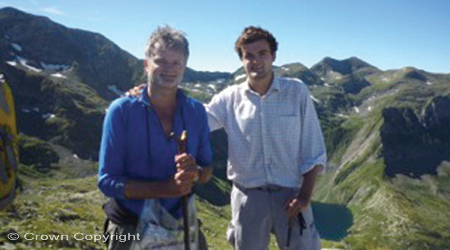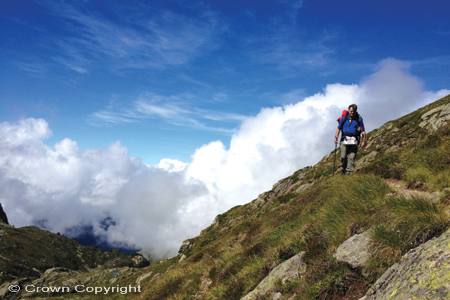|
LE CHEMIN DE LA LIBERTÉ
Following one of the hardest wartime escape routes
across the central Pyrenees into northern Spain
by Paul de Zulueta
formerly Welsh Guards
|
 The author and son at the Col de Pecouch, the Spanish frontier immediately behind them
The author and son at the Col de Pecouch, the Spanish frontier immediately behind them |
On the night of 12th September 1943, a 19 year old mountain guide and ‘passeur’, Louis Barreau, was betrayed by French collaborators - ‘La Milice’. Surrounded by German troops in an isolated barn, now ablaze, above the village of Sentenac-d’oust, he dashed for safety towards the Bois de Plantach. Louis Barreau was cut down before he made 50 metres.
Sixty years on, almost to the day, my younger son, Hughie, and I stood at the marble cross marking the spot where Louis was murdered. By then we had walked for just three hours and 14 kilometres along the ‘Chemin de la Liberté’ from France to Spain. As I gulped some water, Hughie lingered at the memorial lost in thought. He was the same age as Louis had been at his death.
The Chemin de la Liberté is one of several escape routes from France to Spain and, at Grade Five difficulty, its most taxing. The trail runs from the bridge over the Salut river in Saint-Girons (100kms south of Toulouse) to Esterri d’Aneu in Spain. The escape route is just over 50 miles, 35 hours of strenuous plodding, starting at a height of 1290ft and climbing to over 8000ft with an unnerving number of ascents and descents each day. Over the course of the Second World War, there were some 35,000 successful escapes across the Pyrenees by French men and women alone; and around 6,000 by Allied servicemen, mostly aircrew. But of these, only 782 escaped over the mountains of the Ariège - the Chemin de la Liberté, a fact that bears witness to its difficulty.
The ‘good escapee’ says the 1944 document Tips for escapers and evaders ‘is the man who keeps himself fit, cheerful and comfortable; a man with sound common sense and, above all, a man of great determination’. I could not recall any such description from my army confidential reports, and I began to wonder about my motivation for such an arduous journey. The Welsh Guards had given me the priceless gift of friendship and a lasting affection for ‘adventurous training’ ever since a failed attempt to complete the ‘haute route’ across the Alps in the spring of 1978. The evenings were also beginning to draw in on that wonderful ceremony of innocence of carefree holidays with my two sons, the elder now hard at work in the City; the younger, my companion on this journey, now in his penultimate year at university. I was touched he felt the same.
And so we completed the first day from Saint Girons to the manned refuge hut at Aunac, 23 km and ten hours of meandering paths, a compass bearing here and there, a longed-for lunch of salami and strong Pyrenean cheese at the village of Alos with its ‘lavoir’ of ice cold water to replace the five litres we had drunk between us before lunch. I remember that night climbing into my goose down filled sleeping bag, head torch on, reading Rosemary Bartlett’s biography of Tolstoy, a miniature bottle of Lagavulin, cask strength, jostling for attention at my side, and thinking it is life’s contrasts that give it such joy.
September 1943; we tried not to lose sight of what it must have been like for an escapee then. Wearing espadrilles, a tatty suit, maybe an overcoat stuffed with a few sausages and cheese, but little else to sustain them. Hughie and I were ‘Northfaced up’, a toasty refuge hut to look forward to most evenings, a chef to rustle up a warming stew, and little prospect of being ambushed by a patrol from the SS Das Reich Division. I tried also not to forget the 102 ‘passeurs’, men like Louis Barreau who acted as guides on the escape routes who were either shot out of hand, or met an even grimmer end in a Nazi concentration camp. Their names included Louis’s father, Norbert Barreau and Louis’s uncle, Jean. The name Barreau remains revered in the Ariege region.
At first glance, the second day from Aunac to La Cabane de Subera, with just 16 kilometres to walk, seemed relatively trifling. But the geology of the Ariège region of the Pyrenees, dominated by jagged limestone rocks, Mediterranean vegetation, the grass sharp to the touch, makes for hard going. The weather the week before had not been kind and the path became steep and sticky, climbing up 2,000ft to the Col de la Core, down a few hundred feet then up again to the Col de Soulard at 5,210ft. From there, It was a steepish descent to the refuge at La Cabane de Subera at 4,946ft, our billet for the second night. The Cabane has no warden and we had rather hoped for solitude, but found ourselves sharing the manky bunk beds with five Frenchmen who were there until the snow arrived in early October ‘refurbishing’ the hut. After a few skirmishes in our ‘O’ level French, we lapsed into a few desultory hand signals. Sleep should have come easily but, for me, it rarely does above 5,000ft, not helped by one of the Frenchmen, Algerian in appearance, who got up every two hours to make himself a cup of tea.
We started day three unrested and a little anxious. We only had eight miles to walk but with two climbs of just under 3,000ft, at least the day seemed set fair. The mountain ponies of the Merens breed, sturdy and jet black and, so legend has it, used as pack horses during Napoleon’s march on Moscow in 1812, roamed the upper slopes of the Pic de Lampau. Vultures, kites, eagles and buzzards with their plaintive ‘pee-weeeee’ sound swept above us.
After two hours climbing, we came across the wreckage of a four-engined Halifax bomber which crashed here during the last days of the war. A stone plaque in memory of Flight-Sergeant Donald Thorne and six other crew members marks their final resting place, a commemorative wreath of fading poppies, placed in 2004 by former members of 644 Squadron, tied to the plaque. I felt both proud and inexpressibly sad and thought of the final scene of Blackadder Goes Forth and Lieutenant George’s request for ‘permission for lower lip to wobble, sir’.
At around 1pm we made it to the Col de Craberous at 8,000ft. Swivel-eyed marmots sitting bolt upright on the boulders leading up to the Col observed our progress. I remember remarking to Hughie, ‘Well, we’ve broken the back of this little jaunt’. In my experience, such a sentiment is always a precursor to a sharp reversal in fortune. In my complacency, lolling under the cornflower blue sky, I looked across to the Col de Pécouch and reckoned we had just three hours walking until our arrival at the Refuge des Estagnous, one of the more well-appointed huts in the Pyrenees, with not one, but two chefs. I forgot all I had been taught, failed even to take a compass bearing, and toddled off barely casting a backwards glance at the clouds rolling in from the Vallée de Bethmale below.
The afternoon unravelled. We took what I thought was the quicker route to the base of Mt Valier’s peak, now cloaked in heavy cloud and mist, then a traverse for 50 minutes to the Col de Pecouch marked by navigation cairns. But once you miss one cairn, you are likely to miss them all and the mind soon begins to play games, imaginary routes appearing here and there, rational thought slipping quickly away. Some four and a half hours later, I said to Hughie, as calm and steadfast a companion as one could hope to have, ‘look, I’m sorry, I really haven’t much of a clue where we are, cock-up city Idaho beckons, we’d better try and make our way back to where we had lunch’. He looked concerned and touched my face affectionately with his left hand. ‘I think you’re right dad, you do look pooped’.
Retracing your steps. Easily said; never easily done in life. Stumbling across scree and snow, my boots so sure-footed in the Chilterns now like dancing pumps, we shuffled down Mt Valier’s north face, giving each other quiet words of encouragement from time to time. We got back to the Refuge des Espugues, where we’d had lunch, at 7pm, two Mars bars and a bag of nuts between us but, fortunately, plenty of water from the source at the refuge. The shepherdess, living and working in the hut from May to October, viewed me with tired disdain but was good enough to give us a bowl of steaming rice before we rolled into our sleeping bags. I slept fitfully, beating myself up over such a rooky error of judgement, a torchlight procession of ‘what ifs’ running through my mind.
The next morning, and the fine weather had returned, with the views and route to the Col de Pécouch pixel sharp. But the day before had worn us both out, and all that we could manage was to climb to the Col de Pécouch and clamber down to the Refuge des Estagnous. We were now just three hours from the Spanish frontier to the south. It must have been an uplifting moment for those 782 who escaped this way during the war, weary to the point of collapse, ravenous with hunger, but with Churchill’s ‘broad, sunlit uplands’ within their grasp.
We tucked into a lunch of pate, cheese and salami with an ‘ice cold in Alex’ beer. Within half an hour we had slipped into Val d’Isère mode, basking in the early autumn sun. With a twinge of guilt, I remarked to Hughie, ‘It’s still a beautiful day, we’ve got five hours left of sunlight, shall we press on, back for dinner by 7, I would have thought?’ Hughie raised an eyebrow, smiled and carried on reading his book. ‘Well, it was just an idea’, I said.
The next morning was our final chance to make it to the frontier. It was raining hard and we could barely see ten feet in front of us. I chose to ignore the French guide standing next to me. ‘Rassurez-vous, il sera clair au sommet’.
Clear at the summit it may have been, but I reminded myself that goals in life, though important as an aiming mark, often reveal an unconscious wider purpose. We decided to begin the three and a half hour descent to the pre-arranged pick up at the Aire d’acquel, content that we had shared an experience whose memory would endure.
There remained some unfinished business: the Michelin One Star restaurant in Saint Girons. We chose the 35 Euro menu: gateau de fois gras, boeuf de Chalosse, chariot des fromages; and the Armagnac soufflé. Towards the end of dinner, I said to Hughie, ‘Promise me you’ll have a crack at this again when you are 57, with one of your children, God willing’? His face wore a somewhat quizzical almost mocking air. ‘Papa, I rather hoped at 57 I would be on my yacht somewhere in the southern Peloponnese, you’ll be 94 then and I hope still with us, whiskey sour in hand’. We smiled and raised our glasses to one another as the waiter wheeled in the Armagnac soufflé.
 Look what’s behind you! The author oblivious to an impending reversal of fortune
Look what’s behind you! The author oblivious to an impending reversal of fortune |
|
|


